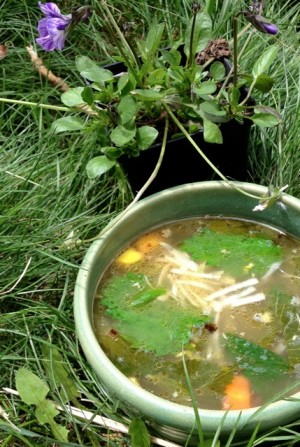Cooking what’s in season with what’s on hand is the mantra at Snowdrift Farm, Teton Valley’s biodynamic, organic farm and CSA. Nestled against the steamy green hills in Victor, Idaho, the farm produces eggs, chickens, pork, vegetables, herbs, and flowers for families and restaurants throughout the Tetons. My task this summer is to feed the “work shares,” the hearty folk who dig, weed and harvest in exchange for their “share” of the bounty. Twice a week I’m charged with dreaming up a thrifty, delicious meal with what comes in from the field—and this early in the season it isn’t much. Last week, however, we had a special treat when an old hen met up with foraged stinging nettles.
If you have ever walked off a trail in the Tetons while wearing shorts and suddenly felt like invisible hypodermic needles that itched like @%$# on your legs you have probably have had a run in with stinging nettles. Hollow stinging hairs called trichomes on its leaves and stems inject irritating chemicals into the skin of humans and other animals upon contact. But like a double-edged sword this plant has impressive nutritional and medicinal qualities and has been used by humans for 2000 years for everything from treating inflammation and arthritis to dandruff to digestive problems.
Stinging nettle can grow up to three feet tall in moist, shady spots, in flood plains, woodlands, near disturbed building sites, and along streams and river banks. It tastes similar to spinach when cooked and is rich in vitamins A, C, iron, potassium, manganese, and calcium and purportedly contains up to 25 percent protein, dry weight, which is high for a leafy green vegetable. Traditionally Native Americans harvested stinging nettle in the spring when other food plants were scarce.
Local Ayurveda practitioner Katie Zeim of Padmaveda says, “Nettles are a blood cleanser, benefit the urinary tract, and are helpful with gout (uric acid build up). They serve as a tonic for the respiratory system and help with asthma, as well as being a good prostate tonic—a good spring tonic overall!”
Cooking or soaking nettles in water will remove the stinging chemicals from the plant. Try using in soups, stews, polenta, pesto, and stir-fries. Here’s what I cooked up:

Ingredients
- 1 pound of chicken, cooked and chopped
- 3 tablespoons soy sauce
- 2 tablespoons white wine or sherry
- 4-5 tablespoons dark sesame oil, separated
- 2 tablespoon fresh ginger, chopped
- 2 cloves garlic, chopped
- 2 large carrots, chopped
- 1/2 cup onion, chopped
- 3-4 cups stinging nettles
- 8 cups chicken broth
- 3 tablespoons tahini
- 1 tablespoon sugar
- 1 1/2 teaspoons hot sauce (chili garlic best) or to taste
- 1 14-oz package Thai rice noodles
Instructions
- Combine chicken, soy sauce, wine or sherry, and 2 tablespoons dark sesame oil in a bowl and soak for 20 minutes at room temperature, or up to two hours in the refrigerator.
- In a stock pot, sauté 2 tablespoons fresh, chopped ginger, and garlic in remaining sesame oil until soft.
- Add the nettles, sauté until wilted, and then add chicken broth, tahini, sugar and vinegar and heat until simmering.
- Add rice noodles and chicken and simmer until noodles are soft, 8-10 minutes.













